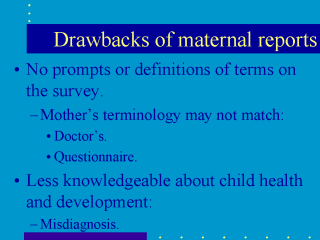 |
There are
several reasons why the sources show such poor concurrence on asthma. If the mother knows
and uses different terms for a health condition than the doctor who told her the child’s
diagnosis, she may not identify that condition on the questionnaire For example, asthma
may have been referred to by the doctor as “wheezy bronchitis” or “reactive airway
disease”, so the mother might not know to mark yes to “asthma” on the questionnaire.
This discrepancy could lead to an artifact of non-concurrence even if the reporting
sources are referring to the same thing. Although physicians are trained to distinguish
normal speech and language development from that which is truly delayed, most parents are
not. For example, in this sample of 3 year-old children, speech problems were reported far
more often by mothers than by medical providers. Some mothers may be hyper-vigilant in
evaluating their child’s speech and may be over-reporting problems, whereas medical
providers may be reporting only clinically meaningful speech problems. On this, and most
other health surveys, the mothers’ questionnaire does not offer any definition of the
health conditions under study. |
